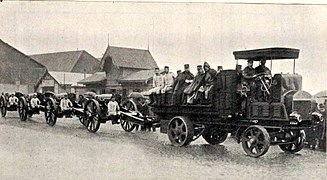A gun carriage is a frame or a mount that supports the gun barrel of an artillery piece, allowing it to be maneuvered and fired. These platforms often had wheels so that the artillery pieces could be moved more easily. Gun carriages are also used on ships to facilitate the movement and aiming of large cannons and Guns. These are also used in the funeral procession of any higher authority of any state and country.

The Mortier de 280 TR Modèle 1914 Schneider was a French siege howitzer manufactured by the Schneider et Cie company, used during World War I. The howitzer had its origins from a Russian Army policy to upgrade its artillery park after the poor showing of Russian artillery in the 1904-5 Russo-Japanese war. In 1909 an agreement was signed between Schneider and the Russian armaments manufacturer Putilov to jointly develop and produce a number of artillery types. One of these types was a 279.4 mm (11-inch) siege howitzer with a range of 6,000 m (20,000 ft) to replace very old Russian guns of similar calibre. Schneider delivered the first prototype of the siege howitzer to the Russians in 1912 for extensive testing. Although the Russians found the gun was unable to penetrate the heaviest reinforced concrete fortifications its general performance was judged satisfactory which led to an order for 16 howitzers to be delivered in 1915. The French Army expressed interest in the Schneider howitzer as a possible replacement for the Mortier de 370 Mle 1885 De Bange. After some dithering by French authorities 18 howitzers were ordered in 1913. Delivery of the howitzers to Russia and France was delayed by the general mobilisation of 1914 which disrupted industrial production. During the war 126 howitzers were delivered to the French Army and 26 to Russia as the 280 mm Schneider Mortar Model 1914/15 before the 1917 revolutions. In addition another 25 barrels were installed post-WW1 on the Saint-Chamond heavy self-propelled gun chassis as the Mortier 280 mm TR de Schneider sur affût-chenilles St Chamond.

The Obusier de 520 modèle 1916 was a French railway howitzer that was built during World War I, but did not see service before the war ended. One weapon was destroyed in firing trials and the other was captured by the Germans after France surrendered in 1940 and used by them in the siege of Leningrad. Both weapons were destroyed by premature detonations of shells in their barrels.

The 155 mm Rimailho Howitzer Model 1904TR was a medium howitzer used by France before and during World War I.

The Mortier 280 mm TR de Schneider sur affût-chenilles St Chamond was a French self-propelled siege howitzer designed during the First World War and used during the Second World War.

The Obusier de 120 mm modèle 1915 Tir Rapide or quick loading 120 mm Howitzer Model 1915 was a French howitzer designed and built by the Schneider company and used by a number of nations during the First World War.

The Obusier de 370 modèle 1915 à berceau was a French Railroad Gun that saw action during the First World War and Second World War.

The Obusier de 400 Modèle 1915/1916 were French railway howitzers that saw action during the First World War and World War II. The mle 1915/1916 was the largest caliber railway howitzers in service with the French Army during the First World War.
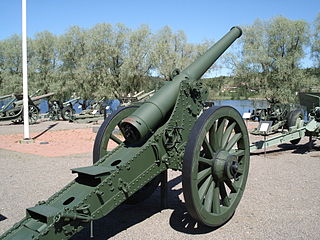
The Canon de 120 mm L modèle 1878 was a French piece of siege and field artillery which was widely used during the First World War and despite its obsolescence, it was still in use by some nations during the Second World War.
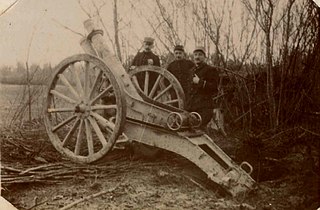
The Obusier de 120 mm C modèle 1890 - was a French howitzer designed by Captain Louis Henry Auguste Baquet and employed by the French army during the First World War. It was one of the first modern howitzers equipped with a recoil system.

The Obusier de 155 mm C modèle 1881 - was a French howitzer designed by Colonel Charles Ragon de Bange and employed by the French army during the First World War.
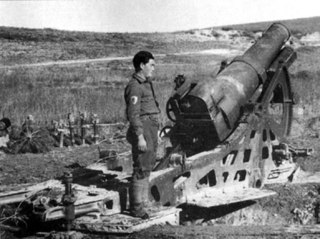
The Mortaio da 260/9 Modello 16 - was an Italian Heavy mortar and Siege Gun designed by the French Schneider Company and produced under license in Italy by Ansaldo and Vickers-Terni for the Italian Army. It was used by the Italian Army during both the First World War and Second World War.

The Canon de 370 modèle 75/79 Glissement was a French Railway gun designed during World War I but produced too late to see action during the war. The six guns built were held in reserve between the wars and were not mobilized by France during World War II.

The Obusier de 200 "Pérou" sur affût-truck TAZ Schneider was a French railway gun built before and served throughout the First World War. It was one of the first French railway guns mounted on a standard gauge rail car during the First World War.

The Obusier de 120 mm C mle 1897 Schneider-Canet was a howitzer built by the French arms company Schneider-Creusot and used by Serbia during the Balkan Wars and World War I.

The 120 mm Armata wz. 78/09/31 and 120 mm Armata wz. 78/10/31 were field guns produced in Poland and used by Poland during World War II and Finland during the Continuation War.

The Peigné-Canet-Schneider mle 1897 gun carriage was a railway gun carriage designed and built during the late 1800s. Two types of guns were mounted on these carriages and both the French Army and US Army used them during World War I. They were retired soon after World War I.

The Mortaio da 210/9 modello 1914 was an Italian Heavy Mortar designed by the French Schneider Company and produced under license in Italy by Ansaldo for the Italian Army and used during the First World War.
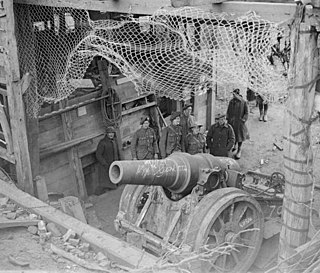
The 21 cm Haubitze M1891 or (21 cm Howitzer Model 1891) in English was a fortress gun built by Krupp that armed the forts of several European countries before World War I. Two countries that bought the M1891 were Belgium and Romania. In Belgian service it was designated Obusier de 21c.A. and in Romanian service it was designated Obuzierul Krupp, calibrul 210 mm, model 1891.




